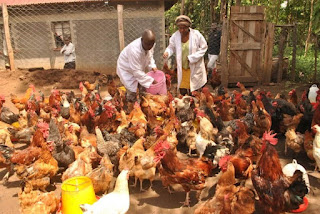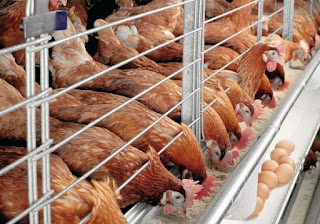Housing Systems of Poultry
There are four different types of
housing systems that poultry farmers commonly use. The type of housing adopted
is mostly determined by the amount of land and capital available.
They are:
1. Free-range or extensive system
2. Semi-intensive system
3. Folding unit system
4. Intensive system
A. Cage (Battery) system
B. Deep litter system
1. Free-range system
This is the oldest approach, and it has been utilized by regular farmers for years in areas where land is plentiful. This arrangement provides birds with a lot of space on land where they can obtain a lot of food in the form of herbage, seeds, and insects, as long as they are protected from predatory animals and infectious diseases like parasite infestation. The system is practically absolute at the moment due to the advantages of intensive methods.
Ø Construction of free-range poultry housing requires less investment. It is the most affordable sort of poultry housing. Because birds can ingest a large amount of feed from grassland, feeding requirements are reduced. Because the bird droppings mix with the soil, this technique helps to preserve fertility.
Ø Drawbacks are, applying scientific management approaches will be challenging. When the birds lay their eggs in the dense grasses of the free-range, you may lose chicken eggs. Predatory animals cause a lot of losses for many farmers in this system. Unless suitable precautions are followed, wild birds may get into contact with your birds and infect them with diseases.
2. Semi-intensive
system
This approach is frequently adopted when free space is limited, but it is still important to provide each bird with 20-30 square yards of outside run. This space should be divided as much as possible, with each bird having a 10-15 square yard run on either side of the house, allowing them to move onto fresh ground.
Ø In comparison to the free-range approach, it is a more cost-effective use of land. This technique protects birds from the effects of extreme weather. In this system, you can use scientific management procedures to a certain level. However,
Ø Fencing is expensive.
Ø Cleaning and removal of litter particles
from the pen should be done on a regular basis.
3. Folding
unit System
This housing system is a relatively
new development. The position of the birds in a movable folding unit is changed
every day, providing them fresh ground, and the birds find a significant amount
of their feed from the herbage, making them healthier and harder.
The disadvantages are that food and water must be carded out to the birds, and eggs must be brought back, and the regular movement of the fold units requires more labor. The folding unit designed for 25 chickens is the most convenient to handle. As with the intensive system, each bird should have a floor area of 1 square foot in the house and 3 square feet in the run, for a total floor space of 4 square feet per bird. A folding house for 25 birds should be 5 feet wide and 20 feet long, with the house being 5' X 5', or one third of area for run. The section closest to the house is covered, but the remaining 10' is left open with wire netting sides and lop.
Ø Because the birds pick most of their
food on the range, you spend less on feeding them.
Ø This strategy, like the free-range system, aids in the fertilization of the soil.
Ø You must carry food and water to the
birds and return them at regular intervals.
Ø Every day, extra labor is required to
move the fold units around in this system.
Ø It costs more than the previous two
housing systems.
4.
Intensive system:
The birds in this system are
completely confined to the house, with no access to land outside, and it is
commonly used in areas where land is limited and expensive. This has only been
made feasible by allowing the sun's direct rays to fall on the house's floor,
causing the windows to either fold or slide down like train windows, allowing
the ultraviolet rays to reach the birds. Intensive poultry housing systems come
in a variety of shapes and sizes.
They are as follows:
§ Deep
litter system
§ Slated
or wired-floor system
§ Combination
of the slatted floor and deep litter system
§ Aviaries
§ Cage
(battery) system
Cage system and deep litter systems
are the most popular in intensive systems.
A.
Cage (Battery)
system
The inventor's most recent
contribution to the commercial egg farmer is this device. This is the most
intensive method of poultry production and is ideal for people who only have a
limited amount of floor space. In today's big cities, it's rare to find someone
who wants to raise chickens on open space. This approach will prove worthy of
maintaining birds in the smallest amount of room for all such persons.
Each hen in the battery system is
confined to a cage that is just large enough for her to stand and sit
comfortably with very limited movement. The standard floor area is 14 x 16
inches, with a height of 17 inches. The floor is made of standard strong
galvanized wire that slopes from back to front, allowing the eggs to roll out
of the cage and into a receiving gutter as they are laid. A tray for droppings
is underneath. Outside the cage are food and water containers. Many
little cages can be joined together, and it can be multistory if necessary. The
entire construction should be made of metal to ensure that parasites are not
retained and that cleaning may be done as needed. This approach has proven to
be incredibly successful in tropical nations when the batteries of cages are
set up in an area that is properly ventilated and illuminated, is not too hot
and vermin proof, and the food meets all nutritional criteria. It's possible
that because it requires the bird to expend the least amount of energy, as it
spends the entire item in the shade, it reduces the burden of excess body heat.
Each bird's performance can be monitored, and culling can be done quickly.
Pullets, which are more commonly utilized than older birds, should be put in
the cages at least one month before they are expected to lay.
The feeding of caged birds must be
carefully considered, as the birds are completely reliant on the feed for their
survival and reproduction. Cod liver oil, yeast, and dried milk powder are
useful for supplying vitamins A and D, as well as fish meal or other animal
protein, balanced minerals, and some sort of grit must be made available.
Because each cage will only contain pullets, fertilized eggs will not be present; instead, vegetative eggs will be present, which can be stored for longer than fertilized eggs at room temperature but cannot be used for hatching.
Pathogens that cause infections are difficult for the birds to pick up. There is no waste of space or food with this strategy. In the cage system of poultry production, disease is also difficult to transmit. You can easily identify cannibalism victims and remove them. In chicken husbandry, cannibalism occurs when a bird pecks at another bird. You can also identify birds with infectious disorders and isolate them for treatment in the same way. The system necessitates less labor. Because the birds cannot nibble on the eggs, there is less egg cracking in this technique. It is easy to collect eggs in this method. This approach also has a lower mortality rate. Cleaning the individual cages and disposing of the manure is challenging.
Drawbacks are depending on the intake of the birds in the cage, food distribution may not be accurate. Cage layer fatigue is a sickness that affects the birds often. The bird is lying on its side, giving the appearance that it is paralyzed. As a result, this is known as cage paralysis or cage layer fatigue. It could be caused by a lack of calcium and phosphorus, although the actual cause is unknown. It necessitates a substantial initial expenditure. Manure handling can be difficult, and flies become a bigger problem in general. Blood spots appear more frequently in eggs. Breast blisters are more common in broilers, especially when the broiler weighs more than 1.5 kg.
B. Deep litter system
The poultry birds in this system are maintained in large pens with up to 250 birds each, on a floor coated in litter such as straw, sawdust, or leaves to a depth of 8-12 inches. The texture of deep litter is similar to that of dry compost. To put it differently, deep litter is defined as the accumulation of litter material with poultry manure until it reaches a depth of 8 to 12 inches. To achieve the intended results, the build-up must be done correctly, which requires very little attention.
·
Safety of Birds: Wild animals, flying birds, and other
predators can take birds on the wing, even in a fenced-in yard. The birds and
eggs are safe when kept in a deep litter dense pen with robust wire netting or
expanded metal.
·
Litter as a source of food supply: It may surprise you to hear that some
of the dietary requirements of birds are met by built-up deep litter. They get
"Animal Protein Factor" from deep litter, and some research suggests
that birds can get enough of it to make a suitable feed ration using only a
vegetable protein like groundnut meal. Vitamin levels, such as riboflavin,
increase by roughly threefold. The combination of this and the Animal Protein
Factor is required for good egg hatchability and early chicken growth.
·
Disease control: Deep litter that is well-managed and kept dry, with no
damp spots near water, has a sterilizing effect. Coccidiosis and worm
infestation are substantially lower in birds (or chickens) housed on good deep
litter than in bare yards and bare floor shelters, especially where water
spillage is allowed.
·
Labor saving: This is one of the most important aspects of using deep
litter. Cleaning out poultry enclosures on a daily or weekly basis is a
significant amount of effort. There is no need to clean a pen out for a year if
proper conditions are observed and well-managed litter is used; all that is
required is regular stirring and the addition of some material.
·
The valuable fertilizer: With deep litter, this is a valuable
economic consideration. 35 laying birds may create around 1 ton of deep litter
fertilizer in a year, according to McArdle and Panda. Fresh manure has a
nitrogen content of about 1%, whereas well-built-up deep litter may have a
nitrogen content of around 3% (nearly 20 percent protein). It also includes
about 2% phosphate and 2% potassium, and its value is almost three times that of
cattle manure.
· Hot weather safeguard: In a hot climate, this is a critical feature. Because the litter maintains its own steady temperature, birds burrow into it to cool off when the ambient temperature is high. When the temperature is particularly cold, they can also warm themselves in the same way. As a result, it is an excellent insulator. In contrast
Ø Bacteria and parasite infections may
be a problem due to direct interaction between the bird and the litter.
Ø Dust from the litter can cause
respiratory difficulties.
Ø Litter is a cost that is not included
in the production cost.
Ø Faults in the ventilation system can
be far more dangerous than those in the cage system.
Summary
This is only a sampling of the
different kinds of poultry houses and housing systems available. The deep litter and cage system are the easiest
to adapt for commercial chicken farming.
In the meantime, I'd like to know
which of these poultry housing systems you prefer.
Will you raise your chickens in a deep
litter system or in a cage system?
Do you want to build a free-range
poultry system or a semi-intensive poultry system with your vast plot of land?
Please let me know what you've decided
in the comments section below.
For more guidance and consultancy feel free to reach out to me. I'd be happy to assist you.











2 Comments
Betway Sportsbook Promo Code - Missouri Online Gambling
ReplyDeleteBetway Sportsbook Promo 정읍 출장안마 Code and Review 남양주 출장마사지 — In 나주 출장안마 essence, 바카라 사이트 에스뱅크 the welcome bonus gives the sportsbook an easy-to-use link and Betway Promo Code: No Code 경주 출장마사지 NeededBetway Sportsbook Promo Type: Betway Sportsbook Promo Offered: NFL, NBA, MLB,
Vampires in the Enchanted Castle casino - FilmFileEurope
ReplyDeleteVampires in 출장샵 the Enchanted Castle Casino. casino-roll.com Vampires in the Enchanted kadangpintar Castle Casino. Vampires in the Enchanted Castle Casino. Vampires in the Enchanted 토토 사이트 Castle Casino. Vampires septcasino.com in the Enchanted